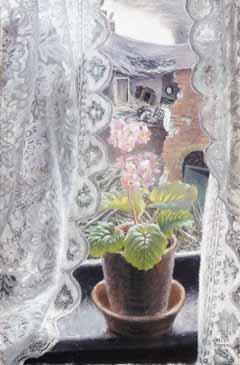Stella Bowen: The house opposite
- Periods:
- To England
- An artist's journey
- Inner worlds
- The return to England
- The war years
Period: The war years

The house opposite
painted in London, 1941
oil on cardboard 60.7 x 39.6 cm
signed l.r., oil “STELLA/BOWEN”, not dated
private collection
The Second World War affected Stella Bowen profoundly, but she recorded the emotional pain it caused her in terms of the physical damage evident around her. To Bowen, the home had long represented peace, but this peace – in the sense of the physical security of the home – was now clearly threatened. The house opposite retains Bowen’s familiar motif of an interior with a view through a window, but the house we see opposite is partly destroyed and there is no sign of life within. What should be a private sanctuary has been scarred, violated, and exposed by the bombing.
The potted primrose, alive and flourishing on the window sill, is a symbol of Bowen’s belief in the regeneration of the human spirit.
Paintings
- Julia
- The house opposite
- Flight from reason
- Embankment gardens
- Admiral Sir Ragnar Colvin
- Bomber crew
- Bombing up a Lancaster for Wing Commander Douglas
- Remains of a flying bomb
- Group Captain Hughie Edwards
- D-Day, 0300 hours, interrogation hut
- Flying Officer Frederick Syme, Sunderland captain
- Pilot Officer Ronald Warfield
- A Sunderland crew comes ashore at Pembroke Dock (F. Syme, Ron Warfield, Ron Tyson, Eric Genders, Charlie Martin, Spud Murphy, Bob Meade, Merv Pike, Jock Beattie, Curly Rowland and John Bishop)
- At the Churchill Club, large and small worlds
- RAAF airmen at Mongewell Park Medical Rehabilitation Unit
- Private, Gowrie House
- Repatriated prisoner of war is processed
- Brigadier George Langley
- Reception desk at Gowrie House, Eastbourne
- Theaden in Kensington
- [Flowers in a green Norwegian pot]